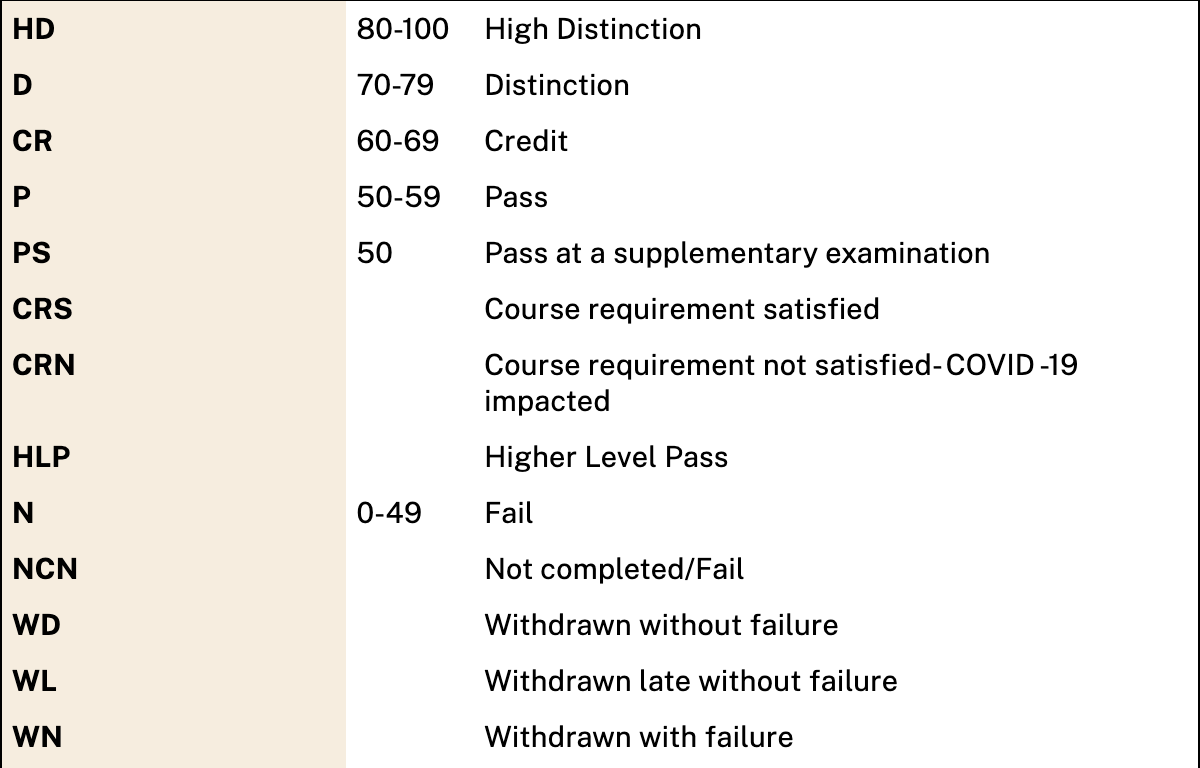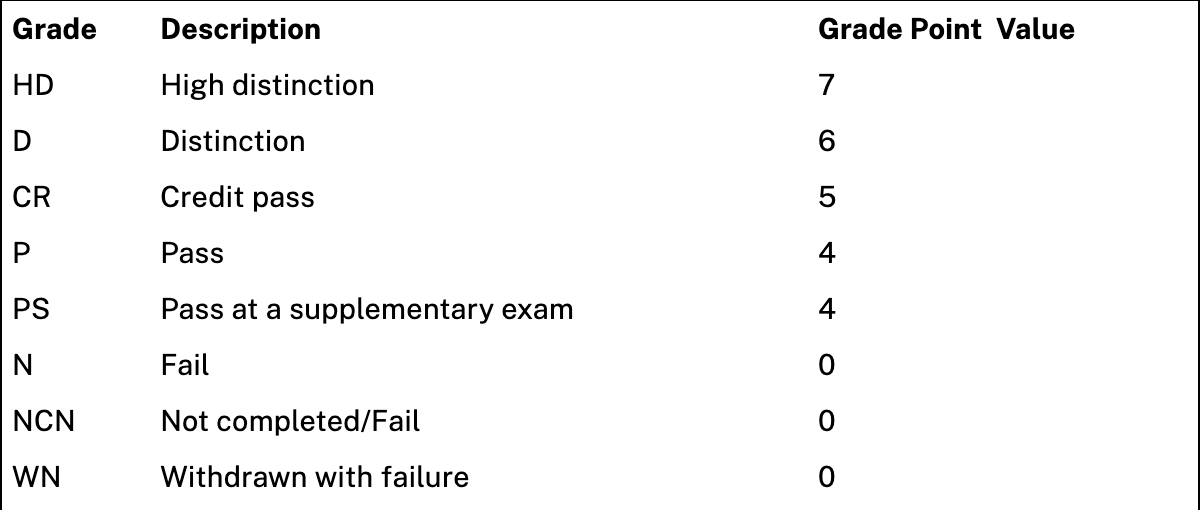A Complete Guide to Grading at ANU

By Tom Kersten
For those new to university, it can be a daunting task to understand the endless terminology. Perhaps most important to understand is the grading process at ANU.
Observer gives an overview of the most important grading terms at ANU.
Grading Scale

The Grading Scale used at ANU
ANU has been using the current grading scale since 1994, and it is consistent University-wide, regardless of your area of study.
When given the final grade of a course that has been studied during the past semester, you will receive a numerical grade alongside a code.
The numerical grade received is your final grade for that course, calculated from assessment / exam marks and the weighting for each of those items.
Then, your numerical grade is translated into one of the above codes, which is used to calculate your Grade Point Average (GPA).
Interim codes may also be received, these indicate that the results are not yet final.

Interim Codes used at ANU
GPA
Grade Point Average (GPA) is an internationally recognised measure of academic performance. It shows the student’s average academic performance over the period of their studies.
When graduating, your GPA will be stated on your academic transcript and it can be an important factor in determining access to postgraduate study or graduate positions at big firms.
Each university may calculate GPA differently. At ANU, a 7-point scale is used, where the code received with your final grade corresponds to a value on the 7-point scale, as seen below.

The 7-Point GPA Scale used at ANU
The GPA score is calculated by multiplying the number of units a course is worth by the final course grade, and adding them all up. This number is then divided by the total number of units undertaken during a certain period.
For example, a student who received a High Distinction, two Distinctions and one Credit during a semester would make the following calculation, assuming all courses are worth six units.
| Course | Grade Code |
Grade Point Value |
Units | GPV*Units |
| Subject 1 | HD | 7 | 6 | 42 |
| Subject 2 | D |
6 |
6 | 36 |
| Subject 3 | D | 6 | 6 | 36 |
| Subject 4 | CR | 5 | 6 | 30 |
| Sum | 24 | 144 |
144 divided by the total units (24) = 6
This student would have a GPA of 6.00.
Your GPA is automatically calculated after each semester, and will appear on your ‘Statement of Results’, which can be accessed through ISIS.
Last year, Observer asked several high-profile individuals, including former Prime Minister Kevin Rudd their thoughts on if GPA is important.
Assessment Task Extensions
If the due date of an assessment was not suitable due to “exceptional circumstances beyond a student’s control”, an extension can be requested.
This can often be done through the Wattle page for a course, and the application must be submitted on or before the due date of the assessment unless specified differently.
Exceptional circumstances can include medical, family, personal or employment reasons.
Documentation or evidence must be included in the application, and a result will be communicated within 8 working days. The result will include the new due date for the assessment.
Should the request be granted but the course convenor believes the student will gain an unfair advantage, an alternative assessment task will be given.
Deferred Exams
The University may allow you to sit a formal examination at a different time to the prescribed time.
This only applies to students who face “extenuating circumstances” which the university defines as “circumstances that were unpredictable and unavoidable”.
Examples of extenuating circumstances could include unexpected illness, the illness or death of a family member, trauma or being the victim of a crime.
An application will need to be submitted via ISIS within 3 days of the scheduled examination date.
Supporting documents will need to be included when applying for a deferred exam, which could include documents from health professionals, a police report, a death certificate, or a letter of support from an ANU staff member.
The ANU website states that if “extenuating circumstances” are caused due to COVID-19 the following documents will also be accepted:
- Online Medical Certificates
- Head of Halls of Residence letter of verification
- Personal statement written by yourself
These documents must all be submitted in English or be accompanied by an official translation.
Students will receive an email regarding the outcome of their application. However, this may not be before the date of their exam. If this is the case, ANU recommends to sit the exam and apply for ‘special assessment consideration’.
Deferred exams usually take place concurrently with supplementary exams, which in 2022 are 25 – 29 July for Semester 1 and 20 – 24 February (2023) for Semester 2.
A guide on how to submit an application can be found here.
Special Assessment Consideration
Should a student have faced “extenuating circumstances” before or during an examination they can apply for special consideration for the marking of their work. This means the marker will take into account the circumstances faced by the student.
This request must be submitted on ISIS within 3 days of the scheduled examination date and documentation must be included, similar to the process for deferred exams. Documentation should also include the date your personal circumstance began or changed, and how your circumstance affected your ability to study.
The course convenor will receive your application and act accordingly.
Supplementary Exams
Should you receive a PX grade, this means that the final grade received for that course was between 45-49. Essentially, the University will give you a second chance to pass the course, by allowing you to sit another exam.
Supplementary exams in 2022 for Semester 1 are held between 25 – 29 July, while those for Semester 2 are only held the following year, between 20 – 24 February. These dates differ slightly each year.
If the supplementary exam is passed, the final course grade will be 50 / PS (Pass at supplementary examination). If the exam is not passed the student will not pass the course, and they will receive N (fail).
Appealing Grades
Should your final grade be different to what you expected, or if you believe certain assessments / exams were unfairly marked, you can appeal your grade.
ANU recommends first seeking guidance about this process from an independent source such as ANUSA or PARSA.
Should you wish to continue with the appeal, ANU states that an informal consideration should first take place via the course convenor. The course convenor must be contacted within 20 days after grades are released, and a grade dispute can be raised.
Usually, the course convenor will re-mark the given assessment / exam, or another person related to the course may re-mark it.
If the outcome of this keeps you dissatisfied, a formal appeal in the form of a letter must be submitted through the Associate Dean of the appropriate college.
ANU states the following must be included in the appeal letter:
- The reasons why the result you received did not fit with a criteria of assessment that was advised to you, or the reason why Assessment Rules or Student Assessment (Coursework) policy or procedure was not followed;
- Confirmation that you have already discussed the result with your lecturer, or if not, why not;
- Any evidence that you have. For example, if your appeal is in regards to an assignment that you have received back, you will need to include it so it can be considered. If it is about an assessment item that has not been returned to you, you will not need to include it as the Associate Dean will have access to it
This letter should be submitted within 20 days of receiving your grade or 20 days after dispute outcome with the course convenor, and the result of the dispute will be given within 20 days of receiving the letter.
A procedural appeal can also take place if the first two steps do not satisfy the student. This can be actioned if university rules, policies and procedures were not properly followed during the first two stages of appeal. The outcome of this appeal is final, and no further action can be taken.
It is important to note that appealing grades can not just result in a higher grade, but also a lower grade.
Graphics by Darlene Rowlands









